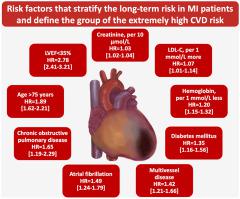Atherosclerosis ( IF 4.9 ) Pub Date : 2021-08-13 , DOI: 10.1016/j.atherosclerosis.2021.08.024 Krzysztof Dyrbuś 1 , Mariusz Gąsior 1 , Piotr Desperak 1 , Przemysław Trzeciak 1 , Jolanta Nowak 1 , Peter E Penson 2 , Tadeusz Osadnik 3 , Maciej Banach 4

|
Background and aims
Risk-factor identification and risk stratification are prerequisites to the effective primary and secondary prevention of cardiovascular disease (CVD). Patients at the highest risk benefit the most from the intensive risk-factor reduction. However, the high-risk patients’ group is heterogeneous, and it is increasingly recognised that there is an ‘extreme-risk’ category of patients who may require particularly close attention and intensive therapeutic approach. The aim of this study was to identify subgroups of patients at the highest risk of death following myocardial infarction (MI) that might be considered as those at extremely high CVD risk.
Methods
We used data from 19,582 participants of the Hyperlipidaemia Therapy in tERtiary Cardiological cEnTer (TERCET) Registry (NCT03065543) of patients with ischaemic heart disease in Poland from 2006 to present. Characteristics of 13,052 patients with chronic coronary syndromes (CCS) were compared with those of 4295 patients with myocardial infarction (STEMI and NSTEMI). Multivariable logistic regression with stepwise backward elimination was used to identify risk factors associated with mortality in the 12–36 months following the index hospitalisation.
Results
The mortality rates were significantly higher in patients after MI than in patients with CCS. In the multivariable analysis, the risk factors most strongly associated with 12-month mortality in patients after MI were left ventricular ejection fraction (LVEF) lower than 35% (hazard ratio [HR] 3.83, 95% confidence interval [CI] 3.14–4.67), age >75 years (HR 1.91, 95%CI 1.55–2.35), multivessel coronary artery disease (HR 1.61, 95%CI 1.30–1.99), atrial fibrillation (HR 1.53, 95%CI 1.21–1.94) diabetes mellitus (HR 1.35, 95%CI 1.11–1.64) and increased LDL-C (HR per 1 mmol/l 1.09, 95%CI 1.01–1.19) or creatinine levels (HR per 10 μmol/L 1.04, 95% CI 1.04–1.05). The risk factors that influenced mortality after 24–36 months were consistent with those after 12 months, with additional low haemoglobin (20–25% risk increase per 1 mmol reduction) and chronic obstructive pulmonary disease (65% risk increase after 36 months).
Conclusions
In our large, single-center real-world analysis, we identified the patients with the highest risk of death who could probably benefit the most from the most intensive therapy, and hence should be considered to be an ‘extreme risk’ population.
中文翻译:

与心肌梗塞后中长期死亡率极高心血管风险相关的危险因素:三级心脏病中心 (TERCET) 注册中的高脂血症治疗分析
背景和目标
危险因素识别和危险分层是心血管疾病 (CVD) 有效一级和二级预防的先决条件。风险最高的患者从强化风险因素降低中获益最多。然而,高危患者群体是异质的,人们越来越认识到存在一类“极端危险”的患者,他们可能需要特别密切的关注和强化治疗。本研究的目的是确定心肌梗死 (MI) 后死亡风险最高的患者亚组,这些患者可能被视为具有极高 CVD 风险的患者。
方法
我们使用了 2006 年至今波兰缺血性心脏病患者在三级心脏病中心 (TERCET) 注册 (NCT03065543) 中的 19,582 名高脂血症治疗参与者的数据。13,052 名慢性冠状动脉综合征 (CCS) 患者的特征与 4295 名心肌梗死(STEMI 和 NSTEMI)患者的特征进行了比较。使用逐步向后消除的多变量逻辑回归来确定与指数住院后 12-36 个月内死亡率相关的危险因素。
结果
MI 后患者的死亡率显着高于 CCS 患者。在多变量分析中,与 MI 后患者 12 个月死亡率最相关的危险因素是左心室射血分数 (LVEF) 低于 35%(风险比 [HR] 3.83,95% 置信区间 [CI] 3.14–4.67 )、年龄 > 75 岁 (HR 1.91, 95%CI 1.55–2.35)、多支冠状动脉疾病 (HR 1.61, 95%CI 1.30–1.99)、心房颤动 (HR 1.53, 95%CI 1.21–1.94) 糖尿病HR 1.35, 95%CI 1.11–1.64) 和增加的 LDL-C (HR 每 1 mmol/l 1.09, 95%CI 1.01–1.19) 或肌酐水平 (HR 每 10 μmol/L 1.04, 95% CI 1.04–1.05) . 影响 24-36 个月后死亡率的危险因素与 12 个月后一致,
结论
在我们大型的单中心现实世界分析中,我们确定了死亡风险最高的患者,他们可能从最强化的治疗中获益最多,因此应被视为“极端风险”人群。











































 京公网安备 11010802027423号
京公网安备 11010802027423号